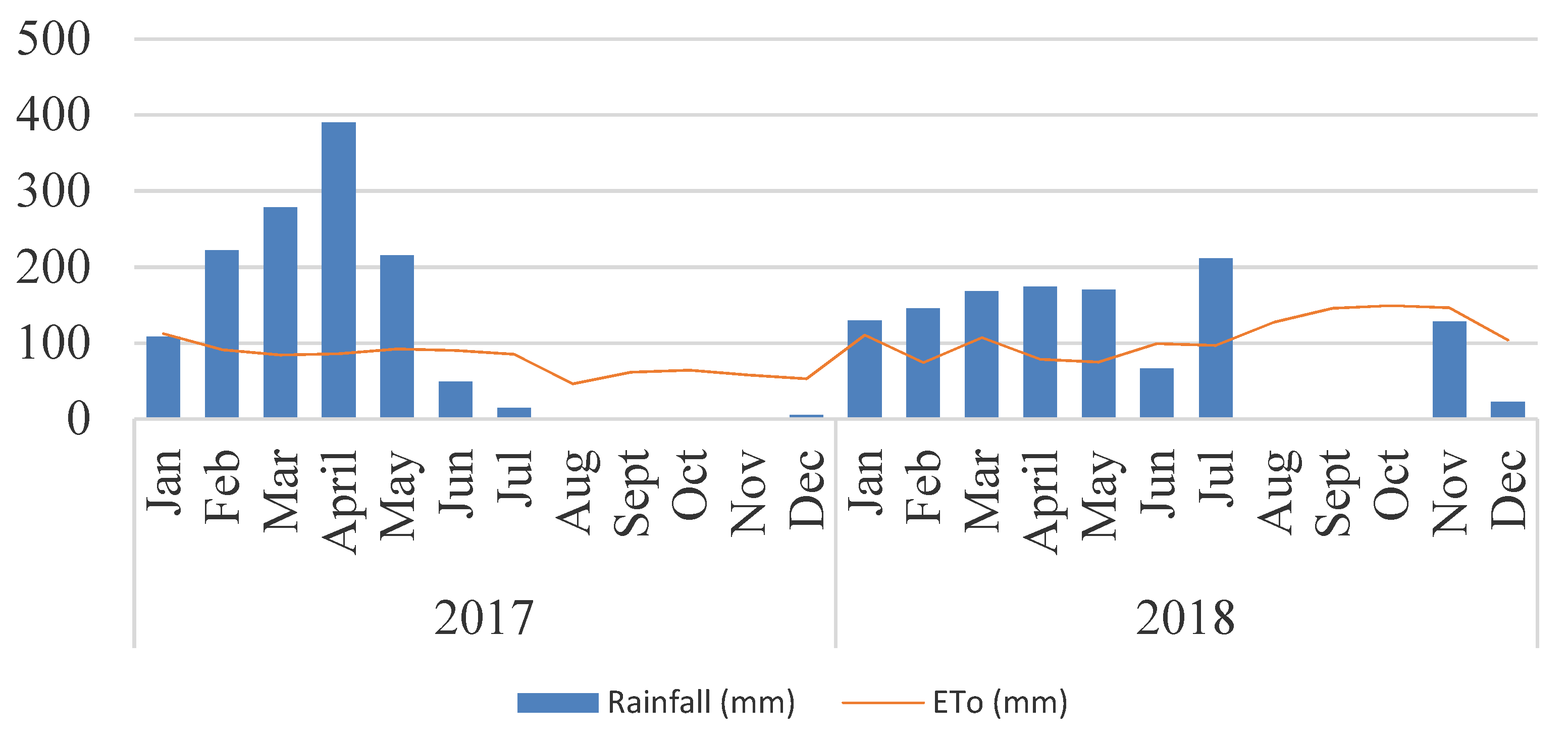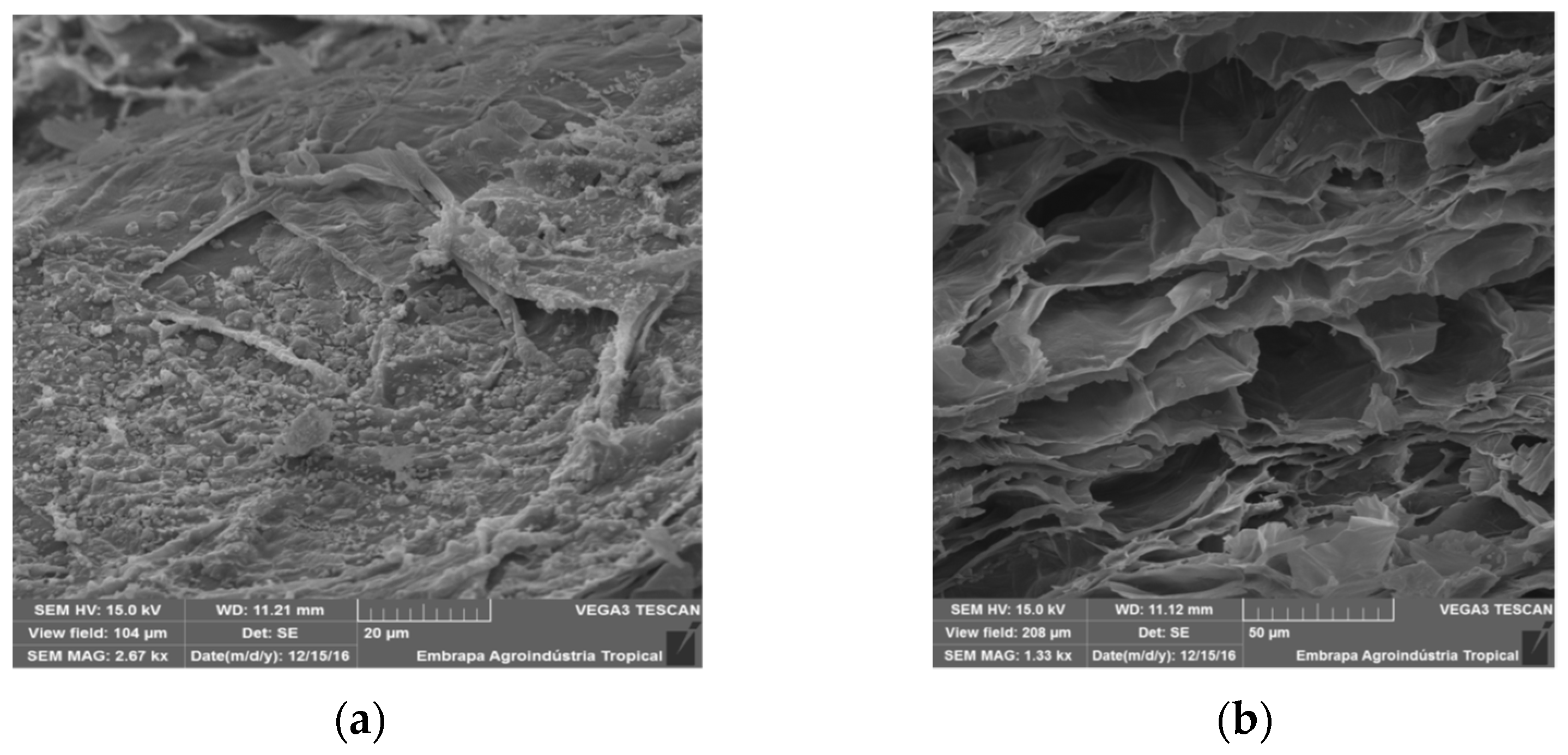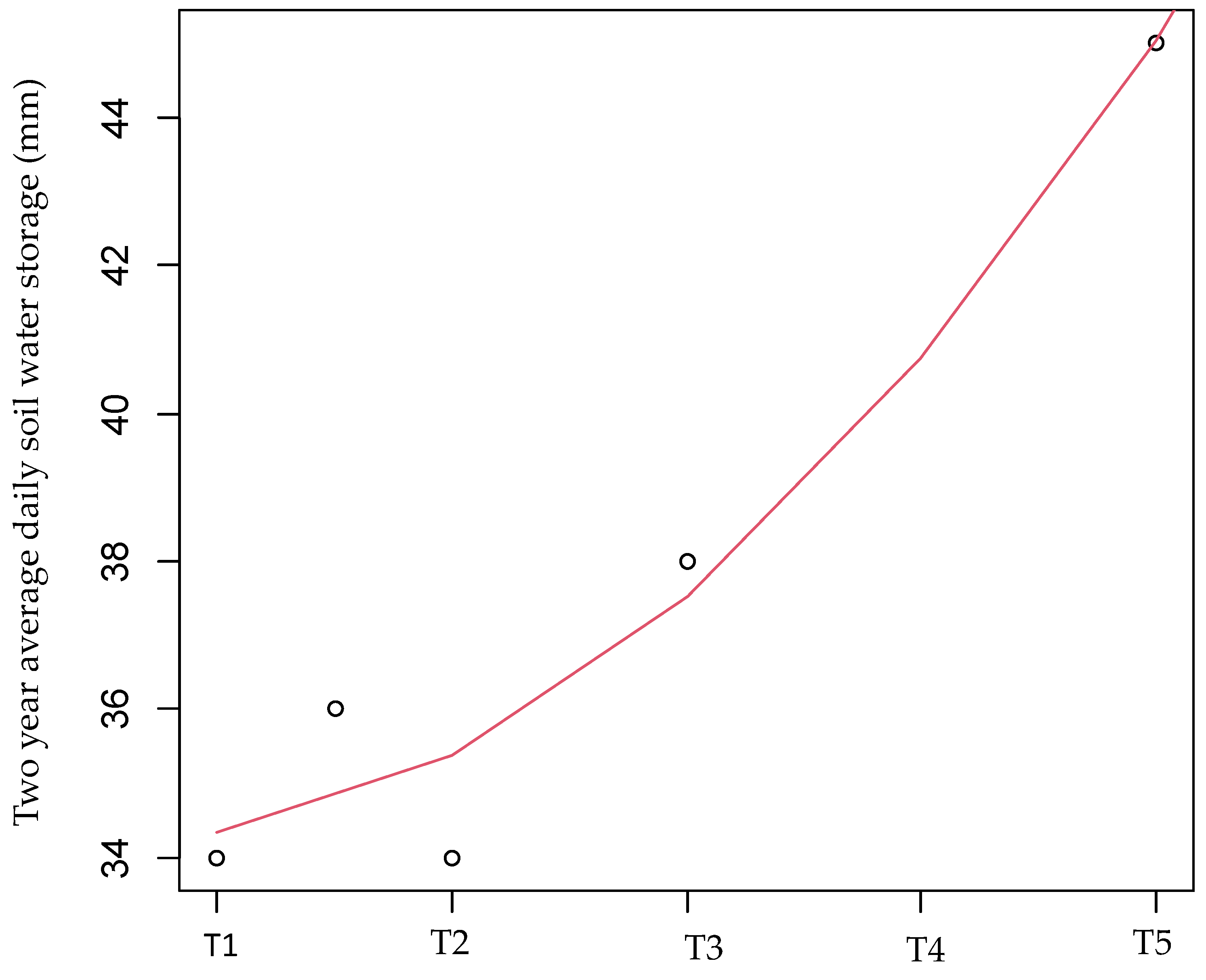Beneficial Effect of Biochar on Irrigated Dwarf-Green Coconut Tree
Abstract
:1. Introduction
2. Materials and Methods
- θ—Soil water content based on volume (cm3 cm−3);
- θr—Residual water volume (cm3);
- θs—Saturation water volume (cm3);
- Ψm—Soil water matric potential (kPa);
- a, n and m—Curve fit parameters.
3. Results and Discussion
3.1. Sun-Dried Coconut Husk Biochar
3.2. Soil Attributes Impacts
3.3. Plant Development
3.4. Soil Moisture
3.5. Irrigation Water
4. Conclusions
Author Contributions
Funding
Conflicts of Interest
References
- Carr, M.K.V. The water relations and irrigation requirements of coconut (Cocos nucifera): A review. Exp. Agric. 2011, 47, 27–51. [Google Scholar] [CrossRef]
- De Miranda, F.R.; Gomes, A.R.M.; Oliveira, C.H.C.; Montenegro, A.A.T.; Bezerra, F.M.L. Evapotranspiração e coeficientes de cultivo do coqueiro anão-verde na região litorânea do Ceará. Rev. Ciênc. Agron. 2007, 38, 129–135. [Google Scholar]
- De Miranda, F.R.; Rocha, A.B.S.; Guimarães, V.B.; da Silva, E.S.; Lima, G.d.C.M.; Santos, S.E.M. Eficiência do uso da água na irrigação do coqueiro anão. Irriga 2019, 24, 109–124. [Google Scholar] [CrossRef]
- Teixeira, A.H.C.; de Miranda, F.R.; Leivas, J.F.; Pacheco, E.P.; Garconc, E.A.M. Water productivity assessments for dwarf coconut by using Landsat 8 images and agrometeorological data. ISPRS J. Photogramm. Remote Sens. 2019, 155, 150–158. [Google Scholar] [CrossRef]
- Basavaraj, G. Yield estimation of coconut in Tumkur district of Karnataka. J. Plant. Crops 2016, 44, 133–140. [Google Scholar] [CrossRef]
- Santos, M.M.S.; Lacerda, C.F.; Neves, A.L.R.; de Sousa, C.H.C.; de Ribeiro, A.; Bezerra, M.A.; Araújo, I.C.d.S.; Gheyi, H.R. Ecophysiology of the tall coconut growing under different coastal areas of northeastern Brazil. Agric. Water Manag. 2020, 232, 106047. [Google Scholar] [CrossRef]
- Laghari, M.; Naidu, R.; Xiao, B.; Hu, Z.; Mirjat, M.S.; Nawaz, K.; Chen, Z.; Guo, D.; Jogi, Q.; Abudi, Z.N.; et al. Recent developments in biochar as an effective tool for agricultural soil management: A review. J. Sci. Food Agric. 2016, 96, 4840–4849. [Google Scholar] [CrossRef]
- Novotny, E.H.; Maia, C.M.B.d.F.; de Carvalho, M.T.; Madari, B.E. Biochar: Pyrogenic carbon for agricultural use—A critical review. Rev. Bras. Ciênc. Solo 2015, 39, 321–344. [Google Scholar] [CrossRef] [Green Version]
- Omondi, M.O.; Xia, X.; Nahay, O.A.; Liu, X.; Korai, P.K.; Pan, G. Quantification of biochar effects on soil hydrological properties using meta-analysis of literature data. Geoderma 2016, 274, 28–34. [Google Scholar] [CrossRef]
- Liu, Z.; Dugan, B.; Maisello, C.A.; Gonnermann, H.M. Biochar particle size, shape, and porosity act together to influence soil water properties. PLoS ONE 2017, 12, e0179079. [Google Scholar] [CrossRef] [Green Version]
- Moragues-Saitua, L.; Arias-González, A.; Gartzia-Bengoetxea, N. Effects of biochar and wood ash on soil hydraulic properties: A field experiment involving contrasting temperate soils. Geoderma 2017, 305, 144–152. [Google Scholar] [CrossRef]
- He, P.; Liu, Y.; Shao, L.; Zhang, H.; Lü, F. Particle size dependence of the physicochemical properties of biochar. Cremosphere 2018, 212, 385–392. [Google Scholar] [CrossRef]
- Miyazawa, M.; Pavan, M.A.; Muraoka, T.; Carmo, C.A.F.S.; Melo, W.J. Análise química de tecido vegetal. In Manual de Análises Químicas de Solos, Plantas e Fertilizantes, 2nd ed.; Silva, F.C., Ed.; Embrapa: Brasília, Brazil, 2009; pp. 191–234. [Google Scholar]
- Muniz, F.L.; Pereira, J.M.R.; Júnior, C.L.X.; Studar, M.D.C. Classificação climática para o estado do Ceará utilizando distintos sistemas de caracterização. In Proceedings of the XXII Simpósio Brasileiro de Recursos Hídricos, Florianópolis, Brazil, 26 November–1 December 2017; Associação Brasileira de Recursos Hídricos: Florianópolis, Brazil, 2017. [Google Scholar]
- EMBRAPA. Sistema Brasileiro de Classificação de Solos, 3rd ed.; Centro Nacional de Pesquisa de Solos: Brasília, Brazil, 2006; p. 353. [Google Scholar]
- Silva, F.C.; Abreu, M.F.; Pérez, D.V.; Eira, P.A.; Abreu, C.A.; van Raij, B.; Gianello, C.; Coelho, A.M.; Quaggio, J.A.; Tedesco, M.J.; et al. Métodos de análises químicas para avaliação da fertilidade do solo. In Manual de Análises Químicas de Solos, Plantas e Fertilizantes, 2nd ed.; Silva, F.C., Ed.; Embrapa: Brasília, Brazil, 2009; pp. 107–189. [Google Scholar]
- Amorim, J.R.A.; Resende, R.S.; de Miranda, F.R. Manejo da Irrigação Localizada na Cultura do Coqueiro-Anão por Meio de Tensiometria. Technical Communication. 2015. Available online: https://www.embrapa.br/en/busca-de-publicacoes/-/publicacao/1041871/manejo-da-irrigacao-localizada-na-cultura-do-coqueiro-anao-por-meio-de-tensiometria (accessed on 2 October 2020).
- Cintra, F.L.D.; Resende, R.S.; Leal, M.L.S.; Portela, J.C. Efeito de volumes de água de irrigação no regime hídrico de solo coeso dos tabuleiros e na produção de coqueiro. Rev. Bras. Ciênc. Solo 2009, 33, 1041–1051. [Google Scholar] [CrossRef] [Green Version]
- Allen, R.G.; Pereira, L.S.; RAES, D.; Smith, M. Crop evapotranspiration: Guidelines for computing crop water requirements. FAO, Irrigation and Drainage Paper 56. Fao Rome 1998, 300, D05109. [Google Scholar]
- Gondim, R.S.; Muniz, C.R.; Lima, C.E.P.; dos Santos, C.L.A. Explaining the water-holding capacity of biochar by scanning electron microscope images. Rev. Caatinga 2018, 31, 972–979. [Google Scholar] [CrossRef] [Green Version]
- Pimenta, A.S.; Miranda, N.d.O.; de Carvalho, M.A.B.; da Silva, G.G.C.; Oliveira, E.M.M. Effects of biochar addition on chemical properties of a sandy soil from northeast Brazil. Arab. J. Geosci. 2019, 12, 70. [Google Scholar] [CrossRef]
- Amonettte, J.E.; Joseph, S. Characteristics of biochar: Microchemical properties. In Biochar for Environmental Management; Lehmann, J., Joseph, S., Eds.; Earthscan: London, UK, 2009; pp. 33–52. [Google Scholar]
- Joseph, S.; Willigen, P. Developing a biochar classification and test methods. In Biochar for Environmental Management; Lehmann, J., Joseph, S., Eds.; Earthscan: London, UK, 2009; pp. 107–126. [Google Scholar]
- Silva, A.R.A.; Bezerra, F.M.L.; Lacerda, C.F.; Araújo, M.E.B.; de Lima, R.M.M.; Sousa, C.H.C. Establishment of young “dwarf green” coconut plants in soil affected by salts and under water deficit. Rev. Bras. Fruticult. 2016, 38, e-206. [Google Scholar] [CrossRef]
- Lima, B.L.C.; Lacerda, C.L.F.; Neto, M.F.; Ferreira, J.F.S.; Bezerra, A.M.E.; Marques, E.C. Physiological and ionic changes in dwarf coconut seedlings irrigated with saline water. Rev. Bras. Eng. Agrícola Ambient. 2017, 21, 121–127. [Google Scholar] [CrossRef] [Green Version]
- Silva, A.R.A.; Bezerra, F.M.L.; Lacerda, C.F.; Sousa, C.H.C.; Bezerra, M.A. Physiological responses of dwarf coconut plants under water deficit in salt-affected soils. Rev. Caatinga 2017, 30, 447–457. [Google Scholar] [CrossRef] [Green Version]
- Fernandes, J.D.; Chaves, L.H.G.; Mendes, J.S.; Chaves, I.B.; Tito, G.A. Alterations in soil salinity with the use of different biochar doses. Rev. Ciências Agrárias 2019, 42, 89–98. [Google Scholar] [CrossRef]
- Han, F.; Ren, L.; Zhang, X.-H. Effect of biochar on the soil nutrients about different grasslands in the Loess Plateau. Catena 2016, 137, 554–562. [Google Scholar] [CrossRef]
- Basavaraju, T.B.; Bhagya, H.P.; Prashanth, M.; Arulraj, S.; Maheswarappa, H.P. Effect of fertigation on the productivity of coconut. J. Plant. Crops 2014, 14, 198–204. [Google Scholar]
- Jayakumar, M.; Janapriya, C.; Surendran, M. Effect of drip fertigation and polythene mulching on growth and productivity of coconut (Cocos nucifera L.), water, nutrient use efficiency and economic benefits. Agric. Water Manag. 2017, 182, 87–93. [Google Scholar] [CrossRef]
- Gondim, R.S.; Serrano, L.A.L.; Maia, A.d.H.N.; da Silva, J.P. Hydrophilic polymer changes the water demand in the implementation of a dwarf cashew orchard. Rev. Eng. Agrícola 2020, 40, 344–351. [Google Scholar] [CrossRef]
- Schulz, H.; Dust, G.; Glaser, B. Positive effects of composted biochar on plant growth and soil fertility. Agron. Sustain. Dev. 2013, 33, 817–827. [Google Scholar] [CrossRef] [Green Version]
- Azevedo, P.V.; Sousa, I.F.; Silva, B.B.; Silva, V.P.R. Water-use efficiency of dwarf-green coconut (Cocos nucifera L.) orchards in northeast Brazil. Agric. Water Manag. 2006, 84, 259–264. [Google Scholar] [CrossRef]
- Lim, T.J.; Spokas, K.A.; Feyereisen, G.; Novak, J.M. Predicting the impact of biochar additions on soil hydraulic properties. Cremosphere 2016, 142, 136–144. [Google Scholar] [CrossRef]
- Villagra-Mendoza, K.; Horn, R. Effect of biochar addition on hydraulic functions of two textural soil. Geoderma 2018, 326, 88–95. [Google Scholar] [CrossRef]





| Parameters | |
|---|---|
| θs | 0.3916 |
| θr | 0.0450 |
| α | 0.4072 |
| n | 2.8803 |
| m | 0.6528 |
| N | P | Mg | Na | S | K | Cu | Fe | Zn | Mn | COT | pH | EC |
|---|---|---|---|---|---|---|---|---|---|---|---|---|
| (g kg−1) | (mg kg−1) | (%) | dS m−1 | |||||||||
| 5.5 | 0.7 | 2.1 | 7.1 | 0.5 | 30.0 | 5.0 | 347 | 15 | 13 | 50.1 | 7.15 | 4.01 |
| Soil Layer (cm) | 0–20 | CV * (%) | 20–40 | CV * (%) | |||||||||
|---|---|---|---|---|---|---|---|---|---|---|---|---|---|
| Treatments (kg Plant−1) | 0.0 | 0.5 | 1.0 | 2.0 | 4.0 | 0.0 | 0.5 | 1.0 | 2.0 | 4.0 | |||
| pH ns | 5.6 | 5.4 | 5.6 | 5.5 | 5.3 | 5.2 | 5.7 | 5.4 | 5.4 | 5.0 | 5.0 | 8.7 | |
| EC ns | dS m−1 | 1.9 | 3.4 | 2.6 | 2.5 | 2.3 | 27.7 | 2.2 | 2.6 | 2.0 | 2.5 | 1.8 | 33.2 |
| K+ ns | mmolc dm−3 | 7.7 | 8.7 | 7.0 | 7.2 | 7.4 | 13.6 | 6.7 | 6.2 | 6.7 | 6.0 | 6.0 | 19.5 |
| Ca++ ns | mmolc dm−3 | 14.2 | 11.6 | 14.0 | 13.8 | 13.2 | 20.9 | 11.0 | 8.0 | 9.8 | 8.6 | 8.1 | 37.2 |
| Mg++ ns | mmolc dm−3 | 9.9 | 9.0 | 11.5 | 9.0 | 9.3 | 17.8 | 5.4 | 5.6 | 6.1 | 4.8 | 5.3 | 29.7 |
| Na+ ns | mmolc dm−3 | 1.9 | 1.5 | 1.3 | 1.9 | 2.2 | 46.3 | 2.6 | 2.0 | 2.8 | 2.3 | 2.5 | 33.0 |
| Log (Al3+) ns | mmolc dm−3 | 1.7 | 1.5 | 1.6 | 1.6 | 1.6 | 10.3 | 0.9 | 0.7 | 0.7 | 0.9 | 0.6 | 28.9 |
| H + Al ns | mmolc dm−3 | 15.1 | 11.3 | 16.0 | 15.6 | 16.0 | 26.7 | 12.4 | 12.6 | 13.9 | 13.7 | 17.0 | 23.2 |
| CEC ns | mmolc dm−3 | 48.8 | 42.1 | 49.8 | 47.5 | 48.1 | 15.8 | 38.1 | 34.4 | 39.3 | 35.4 | 38.9 | 18.7 |
| SB ns | mmolc dm−3 | 33.7 | 30.8 | 33.8 | 31.9 | 32.1 | 14.5 | 25.7 | 21.8 | 25.4 | 21.7 | 21.9 | 23.9 |
| SAR ns | % | 0.40 | 0.22 | 0.24 | 0.38 | 0.46 | 44.6 | 0.66 | 0.56 | 0.70 | 0.64 | 0.70 | 36.7 |
| V ns | % | 69 | 73 | 68 | 67 | 67 | 7.7 | 67 | 63 | 65 | 61 | 56 | 12.3 |
| Treatments | Leaf Number | Plant Height (m) | Stem Diameter (cm) | Number of Leaflets in the 14th Emitted Leaf | Canopy Diameter (m) |
|---|---|---|---|---|---|
| T1 | 16.1 a | 4.7 a | 25.2 a | 145.2 a | 4.3 a |
| T2 | 17.4 a | 5.1 a | 25.3 a | 150.8 a | 4.7 a |
| T3 | 16.7 a | 4.9 a | 25.5 a | 152.3 a | 4.7 a |
| T4 | 18.1 a | 5.0 a | 25.2 a | 153.0 a | 4.8 a |
| T5 | 16.2 a | 4.4 a | 24.7 a | 143.9 a | 4.3 a |
| CV * (%) | 9.4 | 7.5 | 5.2 | 4.2 | 5.8 |
Publisher’s Note: MDPI stays neutral with regard to jurisdictional claims in published maps and institutional affiliations. |
© 2021 by the authors. Licensee MDPI, Basel, Switzerland. This article is an open access article distributed under the terms and conditions of the Creative Commons Attribution (CC BY) license (https://creativecommons.org/licenses/by/4.0/).
Share and Cite
Gondim, R.; Maia, A.; Taniguchi, C.; Muniz, C.; Araújo, T.A.; de Melo, A.T.; da Silva, J. Beneficial Effect of Biochar on Irrigated Dwarf-Green Coconut Tree. Atmosphere 2022, 13, 51. https://doi.org/10.3390/atmos13010051
Gondim R, Maia A, Taniguchi C, Muniz C, Araújo TA, de Melo AT, da Silva J. Beneficial Effect of Biochar on Irrigated Dwarf-Green Coconut Tree. Atmosphere. 2022; 13(1):51. https://doi.org/10.3390/atmos13010051
Chicago/Turabian StyleGondim, Rubens, Aline Maia, Carlos Taniguchi, Celli Muniz, Tácito Almeida Araújo, André Teixeira de Melo, and Janderson da Silva. 2022. "Beneficial Effect of Biochar on Irrigated Dwarf-Green Coconut Tree" Atmosphere 13, no. 1: 51. https://doi.org/10.3390/atmos13010051
APA StyleGondim, R., Maia, A., Taniguchi, C., Muniz, C., Araújo, T. A., de Melo, A. T., & da Silva, J. (2022). Beneficial Effect of Biochar on Irrigated Dwarf-Green Coconut Tree. Atmosphere, 13(1), 51. https://doi.org/10.3390/atmos13010051






